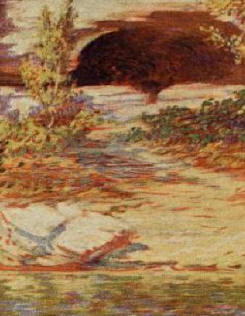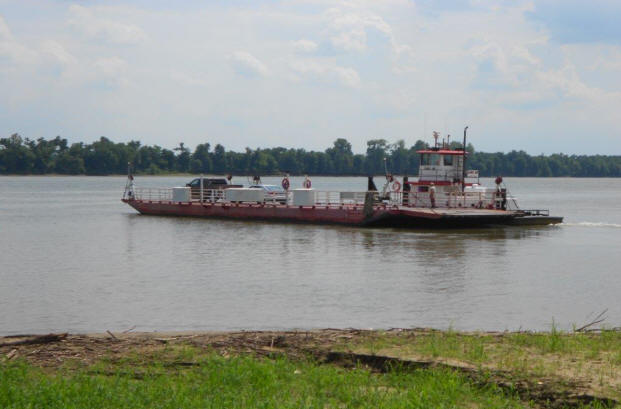.jpg)
 |
Untitled. Oil painting of
Cave-in-Rock by J. Bernhard Alberts,
made
in 1916, from
The Outlaws of Cave-In-Rock. |
About half-way between Paducah
and Evansville, on the southeastern tip of Illinois is
Cave-In-Rock. A free ferry runs between there and Kentucky.
We've taken it many times and never had a long wait.
Both sides of the river have
excellent secondary road connections to interstates and
Cave-In-Rock is also a quant village, with an adjacent state
park. The park has a golf course, lodge, campground, and
restaurant that sit on Pirates' Bluff, walking distance to the
cave.
The Kentucky side of the river is
the location of the state's largest Amish community, with
opportunities to purchase cabinetry, furniture, baked goods, and
seasonal items from individual Amish families.
First, the ferry. I already said
the best part. Free. Second best part, fairly quick, or even
immediate, depending upon the luck of arrival. The ferry just
shuttles back and forth.
Hours are 6:00 to 9:30, seven days a week.
It is a large ferry, three cars wide, and takes about 15
minutes to cross. The Kentucky Ferryboat website is listed below
if you want to be sure the ferry is running.
The ferry trip itself is a wonderful experience and way
to get the feel of the Ohio River, and is an easy way to see
Pirates' Bluff from a distance.
 |
| The car ferry at Cave-In-Rock |
The view from the bluff above
Cave-In-Rock has to be pretty much the same as it was in 1800.
The state park protects the areas above the bluff and it is
still a woodland area.
It does have paved trails, picnic areas, and rest rooms,
but if you turn your back to that you are still looking out
across a wooded view of the Ohio River. The view from the cave
and bluff is worth the stop alone.
M. de Lery, a French explorer,
was the first European to map the cave, naming it Caverne dans
le Roc. That
translates to English as Cave-In-Rock. After the Revolutionary
War, traffic past the cave increased quickly. In the
late-eighteenth and early-nineteenth centuries the Ohio River
would have been that interstate we avoided by taking the ferry.
Pioneers were using the river to reach the frontier,
which still included much of the area on both sides of the
river. Families and all their personal possessions floated by
Cave-In-Rock on their way to a better life.
It was a landmark even at that time that tempted many of
the families to temporarily stop.
That also meant valuables were on the flatboats passing
by, and that made Cave-In-Rock a perfect location for river
pirates. The bluff offers
a long view of the river and its traffic, well before anyone on
a boat could see the cave.
The bluff was beautiful and also attractive, enticing
boatmen near. ThThe
cave was sometimes disguised as an Inn or tavern, and that was
sure to tempt a stop by most boatmen. Some pirates even used
sirens at the cave entrance to attract unwary males.
 |
Pirates' Bluff from the
ferry. Structures on bluff are picnic shelters in park.
Cave is hidden from view |
The standard plan for river
pirates was to place some of their gang on shore where they
would hail a passing boat feigning distress and ask for
transportation to the next settlement.
The crew might lose its cargo (and lives) if it pulled
ashore, or the pirates could go along for the ride and cause it
to sink near the rest of their gang.
There are lots of river pirate
stories. Some are true history and some are local legend; it is
often hard to tell one from the other. There a dozens of river
pirate stories centered on the cave; The Outlaws of
Cave-In-Rock by Otto A. Robert does a great job of telling
some of the best stories (it is 364 pages available via free
access on the internet, see link below).
TheThe book has a chapter on
the early history of the cave in terms of Native Americans,
early explorers and pioneers, and then tells the stories of some
very interesting river pirates, including Samuel Mason and the
Harpe Brothers.
 |
| Inside Cave-In-Rock. |
Samuel Mason, in 1797, was an
early pirate. Using
the alias of Jim Wilson, he erected a large sign near the
entrance of the cave that read, "Wilson's Liquor Vault and House
for Entertainment." What boatman would not stop for that! Once
inside, the river pirates would size them up. Either the boatmen
would be robbed at the cave, or if more time was needed, one of
the pirates would offer to pilot the boat through a bad eight
mile stretch just down river. The pilot would swamp the boat at
an island down river where the rest of the gang waited. Soon the
cargo was back on its way to New Orleans, but under control of
the pirates. So much cargo was lost that the Pittsburg merchants
put a price on Mason's head.
His head eventually showed up in Pittsburg so the reward
could be collected.
The rest of the body was burned back in Illinois.
 |
| Distinctive view to the outside
of Cave-In-Rock. |
The Harpe Brothers (Big Harpe and
Little Harpe) were perhaps the most notorious criminals in
Tennessee and Kentucky history. They made their living from
crime, mainly as highwaymen who murdered unlucky travelers. For
a while they were river pirates at Cave-In-Rock. They had a
reputation of being some of the worst of the murderous, mean
frontier criminals.
Once they found two lovers atop the bluff and pushed both of
them off. Another
time a boatman was taken to the top of the bluff, tied to a
blindfolded horse, and the horse was made to run off the cliff.
Both died. The Harpe Brothers were so mean that the river
pirate community ran them off.
That has to be very mean.
Cave-In-Rock has authentic river
pirate history and still appears to be an ideal lair for
murderous river pirates and others seeking to evade the law.
It is an ideal movie location to feature river pirates
and has seen service for just that use.
How the West Was
Won, a 1962 Western movie classic has a segment that
features the cave.
An emigrant family traveling down the Ohio River runs stops at a
trading post run by a band of river pirates that operate out of
the cave. Walter
Brennan plays Col. Jeb Hawkins, the leader of the river pirates.
Movie trailers are available on-line (links below) and
clearly show the distinctive cave entrance from inside. If you
are old enough, you'll remember Walt Disney's
Davy Crockett and the
River Pirates. What better place to film a pioneer river
pirate movie that Cave-In-Rock? In this movie Davy and his
friend George Russell go down river to sell some fur pelts in
New Orleans. They
encounter "treacherous river pirates, dangerous rapids, and
excitement at every turn." On
the way they "discover that the river pirates are masquerading
as Native Americans as they loot passing freighters from a
riverside cave. They
find their way into the lair, and in the ensuing battle several
kegs of gunpowder are exploded, sealing the cave. The victorious
heroes escape unscathed with the subdued villains in tow."
CavCave-In-Rock was the cave used in that scene, and, of
course, it really was not sealed, as Walter Brennan was pirating
out of it six years later. Movie trailers are also available for
this film (see links below).
 |
| The ferry from near the entrance
of the cave. |
History's Mysteries on the
History Channel did an episode on river pirates in 1998 that was
filmed at Cave-In-Rock, which included reenactments and expert
commentary showing the dangers that settlers encountered while
travelling down the Ohio River during the early nineteenth
century. It included
profiles of Big and Little Harpe, who are believed to have
murdered nearly 40 travelers.
The great advantage of this side
trip is that all of this is only a mile or so from the ferry
landing. It is a great place to spend an hour or a day.
It is perfect for a picnic lunch. The cave is not deep
and scary. The
entrance is about 55 feet across, the inside is about 40 feet
across, and the cave is only about 160 feet deep. The ceiling is
high and at the back is a small opening at the top that lets in
sunlight. So it is not a super dark cave. The cave is about
half-way up the bluff from the river, but a well-maintained path
leads to it. Where else are you going to get river pirates on a
road trip, except maybe Disney World?
Even Disney's television pirates were not imaginary. They
were based on Cave-In-Rock. This is American history at its most
interesting, even if the liquor vault and
entertainment house are no longer there.
Authors:
Tom Straka is a forestry professor at Clemson University in
South Carolina. His wife, Pat, is a consulting forester. Both
have a keen interest in roadside history.
For
more information:
The Outlaws of Cave-In-Rock
by Otto A. Robert (Cleveland: Arthur H. Clark Co., 1924):
https://archive.org/details/outlawsofcaveinr00roth
Two movie trailers
for How the West Was Won:
New York Times,
two trailers, first is seconds 49 – 53 and second is seconds40
-45:
http://www.nytimes.com/movies/movie/23458/How-the-West-Was-Won/trailers
Turner Classic Movies, original trailer, seconds 5 -7 and
117-123:
http://www.tcm.com/mediaroom/video/16772/How-the-West-Was-Won-Original-Trailer-.html
Movie trailer and
clips for Davy Crockett
and the River Pirates:
http://www.stafaband.info/watch/zCzUayJUj98/disneycember_davy_crockett_and_the_river_pirates/
http://www.youtube.com/watch?v=BFds0OcuMHU
Cave-In-Rock State
Park:
http://dnr.state.il.us/lands/landmgt/parks/r5/caverock.htm
Cave-In-Rock State
Park Lodge and Restaurant:
http://caveinrockkaylors.com/Home_Page.html
Kentucky side of the
river:
http://www.marionkentucky.org/?gclid=COGl2b6zu78CFeXm7AodJi4AeQ
Kentucky
Transportation Cabinet Ferry Website:
http://transportation.ky.gov/ferries/pages/default.aspx?Title=Cave%20in%20Rock%20Ferry
Editorial note header image is View of Cave-In-Rock circa
1832 by Karl Bodmer from "Maximilian, Prince of
Wied's Travels in the Interior of North America, During the
Years 1832–1834."
|
![]() Ads fund American Roads so please consider them for your needed
purchases.
If you enjoy the articles we offer, donations
are always welcome.
Ads fund American Roads so please consider them for your needed
purchases.
If you enjoy the articles we offer, donations
are always welcome.
----------
|